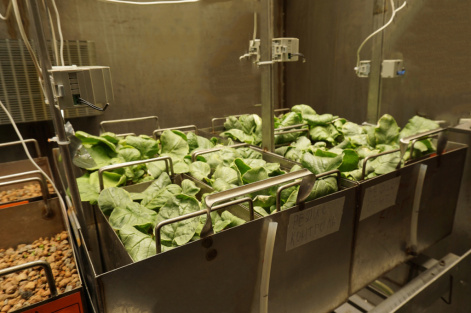Krasnoyarsk scientists: NASA requirements to the diet of cosmonauts need correction
6 May 2019 г.

Distant space flights, e.g., for two years and longer and colonization of other planets have not only been a dream of science fiction writers, but the real goal of scientists and engineers. To make them real a number of important tasks have to be solved. One of them is food for astronauts whose diet must correspond to the nutrition norms. For this purpose NASA developed documents regulating «the space diet».
Krasnoyarsk scientists have checked the possibility of meeting the NASA requirements to the diet of cosmonauts under the conditions when the main food would be produced in the bio-regenerative life support system on board a spaceship or in a planet space station. The study reveals that the stated norms are hard to fulfill. In all the variants of the ready «menu» NASA requirements are broken, for example, concerning the iron content, whose consumption turns out to be higher than necessary or vitamins B5and D, which are insufficient in the diet.
In order to find out how realistic the NASA requirements are, the scientists made a list of 46 food sources which included cereals, vegetables, oil-bearing and legume crops, as well as root vegetables, berries, mushrooms and meat of some animals. These food items were included into the list if they had been considered, either theoretically or experimentally, to be suitable for consumption in the life support system. Further, using a computer software the researchers formed food sets, each consisting of 10 - 46 food items.
«We have found out that using 20-25 food sources provides the maximum correspondence of the calculated consumed nutrients to the NASA norms. Further growth in the set size gives the increased food diversity but does not allow providing a balanced menu.», explains one of the researchers, Candidate of Biological Sciences, senior research associate of the Institute of Biophysics SB RAS Vladimir Kovalev.
The best correspondence to the NASA norms is achieved in the case of a daily food set including salt, rice, potatoes, beetroot, cabbage, carrots, courgettes, rape oil, safflower oil, soya, cheakpeas, peas, strawberries, onions, garlic, poultry meat, snail meat, fish, milk, sugar. But even this set does not eliminate the deficit of vitamins B5 and D, and the excess of iron in the diet. «The problem is more likely to be solved using vitaminized food and vitamins in the form of drugs», says Vladimir Kovalev.
In the NASA norms the daily consumption of omega 6 fatty acids, vitamins D, K, E, C, B12, B5, B6, thiamine, riboflavin, folic acid, niacin, biotin, magnesium, potassium, manganese, fluorine, zinc, iodine and chromium is strictly regulated. Under such strict requirements it is not possible to completely eliminate the discrepancies between the calculated nutrient content and NASA norms. To make the NASA recommendations attainable it is necessary to determine daily minimum and maximum limits for the above-mentioned substances.
Determining the minimum set of food sources to be taken to space for the creation of a closed life support system is one of the research stages of the Krasnoyarsk biophysicists. The possibility to grow some species of plants and provide food for the experimentalists in the closed system has already been tested in long-term experiments. However, it is still early to speak about using such systems in space. At least, until scientists have tested the ability of suitable plants and animals to breed in space.
Share:
